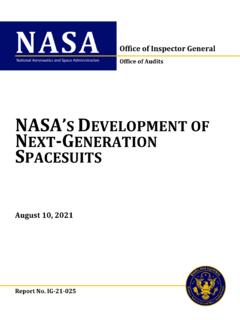Transcription of International Space Station Transition Report - January 2022
1 International Space Station Transition Report pursuant to Section 303(c)(2) of the NASA Transition Authorization Act of 2017 ( 115-10) January 2022 Table of Contents The International Space Station : The Next Decade The International Space Station Transition Plan ISS Transition Budget Planning ISS Technical Health and De-O rbit Plan Goals For The Next Decade Enable Deep Space Exploration Conduct Research To Benefit Humanity Foster A Commercial Space Industry Lead And Enable International Collaboration Inspire Humankind 2
2 THE International Space Station : THE NEXT DECADE This Report responds to direction in the National Aeronautics and Space Administration Transition Authorization Act of 2017 ( 115-10, hereafter the Act ), Section 303(c)(1), to submit to Congress a Report evaluating the International Space Station (ISS) as a platform for research, deep Space exploration, and low-Earth orbit (LEO) spaceflight in partnership with its four International Space agency partners, and the commercial Space sector.
3 This Report is an update to the International Space Station Transition Report , dated March 30, This version updates the plan to Transition the LEO activities of United States Government agencies, ISS International Partners, ISS National Laboratory (ISSNL) users, researchers, industry, academia, and other ISS commercial partners off the ISS and onto Commercial LEO Destinations (CLDs) by 2030. It details the goals for the next decade of ISS operations leading to a smooth Transition to commercial services, the steps being taken to develop both the supply and demand side of the LEO commercial economy, and the technical steps and budget required for ISS Transition .
4 The ISS is the world s preeminent orbital microgravity research platform for research and development. For more than 20 years, scientists and researchers have used the ISS to conduct research into biological, physical, biomedicine, materials, and Earth and Space science. Technology demonstrations and development aboard have advanced the state-of-the-art for applications with benefits both on Earth and in Space . Climate sensors deployed on ISS have validated climate models and contributed a host of new information about Earth s changing climate environment, while Space science instruments on ISS have advanced our knowledge of phenomena including neutron stars and dark matter.
5 The ISS crew itself has been a critical part of the experiment as well, volunteering themselves as test subjects for research into human adaptation to living and working in microgravity. Without these long-duration demonstrations and experiments into the joint human-and-vehicle system, human exploration of the solar system will not be possible. The ISS is now entering its third and most productive decade of utilization, including research advancement, commercial value, and global partnership. The first decade of ISS was dedicated to assembly, and the second was devoted to research and technology development and learning how to conduct these activities most effectively in Space .
6 The third decade is one in which NASA aims to verify exploration and human research technologies to support deep Space exploration, continue to return medical and environmental benefits to humanity, continue to demonstrate leadership in LEO through International partnerships, and lay the groundwork for a commercial future in LEO. Today, with commercial crew and cargo transportation systems online, the ISS is busier than ever. The ISSNL, responsible for utilizing 50 percent of NASA s resources aboard the ISS, hosts hundreds of experiments from other Government agencies, academia, and commercial users to return benefits to people and industry on the ground.
7 Meanwhile, NASA s research and development activities aboard are advancing the technologies and procedures that will be necessary to send the first woman and first person of color to the Moon and the first humans to Mars. The ISS is entering an era of robust commercial use, taking advantage of the utilities provided by the ISS to develop the capabilities industry needs to move from being dependent on NASA for Space Station utilization to providing the platform(s) the Agency will need to continue its mission in LEO after the lifetime of the ISS.
8 Commercial crew and cargo transportation are well known examples of the commercial ecosystem supporting ISS, and today they provide the vital lifeline from Earth to the ISS. Perhaps less known are over 20 commercial facilities operating aboard ISS today including a 3D 1 3 printer, a bioprinter.
9 External Earth observation and materials platforms, and an airlock that are available for use by both NASA and other paying customers. Commercial engagement is one step towards ensuring Space continues to thrive beyond ISS. NASA awarded the use of an ISS docking port to Axiom Space , which plans to attach a series of commercial modules that will eventually detach to become a LEO free-flying destination. NASA has also signed agreements with three companies (Blue Origin of Kent, Washington; Nanoracks LLC of Houston, Texas; and Northrop Grumman Systems Corporation of Dulles, Virginia) to develop commercial destinations in Space that go directly to orbit, , free-flyers.
10 The awards, along with the Axiom concept, are the first part of a two-phase approach to ensure a seamless Transition of activity from the ISS to commercial destinations. During this first phase, private industry, in coordination with NASA, will formulate and design CLD capabilities suitable for potential Government and private sector needs. The first phase is expected to continue through 2025. For the second phase of NASA s approach to a Transition toward CLDs, the Agency intends to certify for NASA crew member use CLDs from these and potential other entrants, and ultimately, purchase services from destination providers for crew to use when available.










